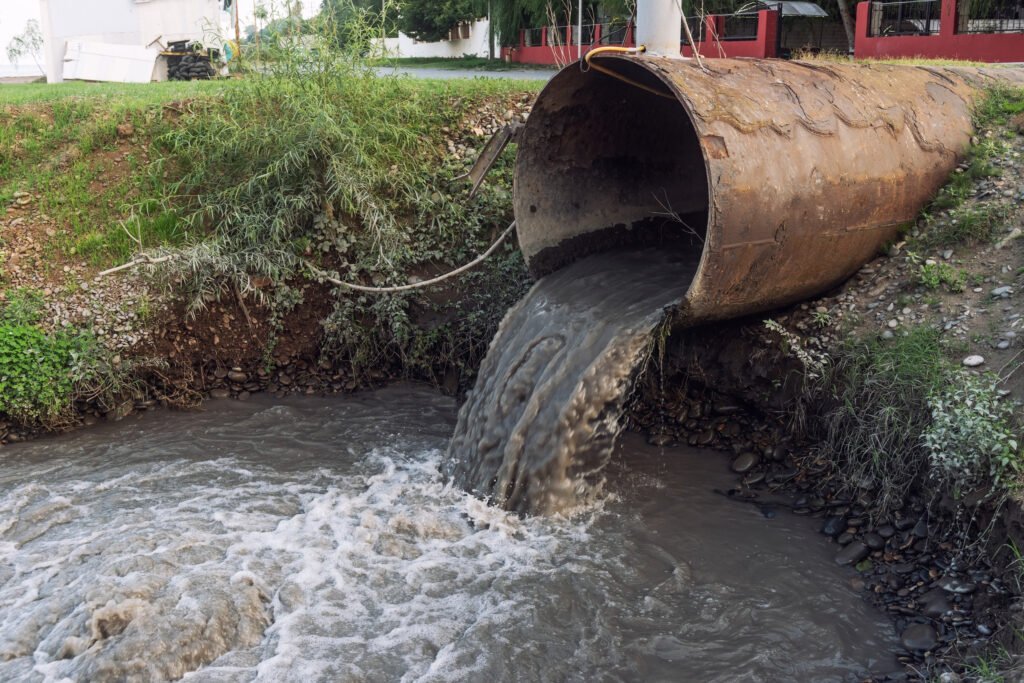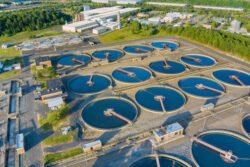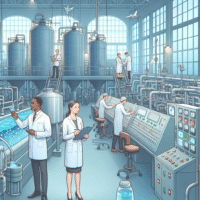Contaminants and Contamination: Understanding Their Sources and Impact

Contaminants in our environment can have severe effects on human health and ecosystems. Every year, millions suffer from exposure to various pollutants found in the air, water, and soil. Understanding where these contaminants come from and how they affect us is crucial for taking preventive measures and staying safe.
Water, one of our most vital resources, is often contaminated by chemicals, heavy metals, and pathogens. This contamination can originate from industrial waste, agricultural runoff, and even household chemicals. Ensuring the safety of our drinking water involves not just treatment and filtration but also regular monitoring and maintenance of water sources.
Regulatory bodies play a significant role in managing contamination and protecting public health. Agencies like the EPA set guidelines and conduct testing to limit exposure to harmful substances. By staying informed about regional contamination issues and using effective water filtration methods, communities can better protect themselves from the dangers of contaminated water.
Key Takeaways
- Contaminants impact health and ecosystems.
- Water contamination needs vigilant monitoring and treatment.
- Regulatory agencies help manage and reduce exposure.
Understanding Water Contamination
Contaminated water is a critical issue impacting both the environment and public health. This section explores the different types of water contaminants, their sources, and the potential health impacts of consuming or coming into contact with contaminated water.
Types of Water Contaminants
Water contaminants come in many forms including chemical, biological, and physical substances. Chemical contaminants can include heavy metals like lead and mercury, as well as industrial chemicals such as perfluoroalkyl substances (PFAS). Biological contaminants encompass bacteria, viruses, and parasites that can cause disease. Physical contaminants primarily consist of sediments or particulate matter which can affect water clarity and quality.
Sources of Water Contamination
Water contamination can originate from various sources. Industrial discharges and agricultural runoff are significant contributors. Factories can release harmful chemicals into rivers and streams, while farms often contribute pesticides and animal waste. Municipal wastewater treatment plants also play a role, although they aim to reduce the number of contaminants before the water is released back into the environment. Natural sources, like soil erosion, can add sediments to water bodies.
Health Impacts of Contaminated Water
Exposure to contaminants in water can lead to severe health issues. Chemical contaminants like PFAS have been linked to various cancers and liver damage. Biological contaminants can cause gastrointestinal illnesses, respiratory issues, and in severe cases, long-term health problems. Even physical contaminants can be harmful; sediments can harbor bacteria and parasites, leading to infections. Ensuring water safety is crucial to prevent such health risks.
For more information, visit the EPA’s fact sheet for communities or the Washington State Department of Health on coliform bacteria.
Groundwater Contamination
Groundwater contamination arises both from natural sources and human activities. It impacts drinking water quality and poses health risks. Understanding how contaminants move through groundwater and preventive measures is crucial for safeguarding this resource.
Contamination Transport and Remediation
Groundwater contamination often spreads through the movement of water within an aquifer. After rainfall, water infiltrates the ground and can carry pollutants from the surface. This process, known as leaching, can introduce contaminants like pesticides and heavy metals into the groundwater.
Contaminants can come from a variety of sources. Natural sources include elements like iron and manganese. Human activities, such as agriculture, industry, and waste disposal, contribute significantly to pollution. These activities release chemicals and waste products that seep into the soil and eventually reach groundwater.
Remediation involves removing or reducing contaminants. Techniques include pumping contaminated water to the surface, treating it, and returning it to the ground. Another method is bioremediation, which uses microorganisms to break down pollutants. In situ methods, like chemical oxidation, treat the contamination directly in the ground without removing the water.
Preventing Groundwater Contamination
Preventing groundwater contamination requires proactive measures. Proper disposal of industrial waste and limiting the use of harmful chemicals in agriculture are essential steps. Regulations and guidelines from agencies like the U.S. Environmental Protection Agency help enforce these actions.
Sealing wells properly can prevent contaminants from entering aquifers. Monitoring wells and regular water quality testing are also crucial to detect and address contamination early. Awareness and education about best practices for waste management reduce the risk of accidental contamination.
Another key preventive step is regulating land use near water sources. Maintaining buffer zones around water bodies helps to filter out potential contaminants. Additionally, investing in improved infrastructure for sewage and waste disposal reduces the likelihood of pollutants seeping into the ground.
Drinking Water Safety
Ensuring the safety of drinking water is important for preventing health issues related to contamination. Contaminated water can cause various diseases, so understanding signs and precautions is crucial.
Signs of Contaminated Drinking Water
Contaminated drinking water can present several warning signs. A change in taste, odor, or color can indicate the presence of pollutants. Common contaminants include chemicals, metals, and microorganisms. For example, water that smells like chlorine or has a metallic taste might be unsafe.
Another sign of contamination is cloudiness or particles floating in the water. Biofilms, which are slimy layers of bacteria, can form in pipes and cause discoloration. Additionally, illnesses such as diarrhea, nausea, and stomach cramps can suggest that water is contaminated. Regular testing and noticing unusual symptoms in multiple household members can help identify these issues early.
Protecting Against Contaminated Drinking Water
Taking steps to protect against contaminated drinking water involves several actions. One primary method is using water filters certified to remove specific contaminants. This can help reduce the risk of exposure to harmful substances.
Another key measure is ensuring that municipal or private water supplies are regularly tested. Bottled water is also an option, but consumers should verify that it meets safety standards. Additionally, communities can advocate for proper infrastructure maintenance to prevent issues like lead in the water supply.
Storing water in clean, covered containers can prevent contamination. Boiling water before use can kill harmful microorganisms, making it safer for consumption. It’s also important to stay informed about local water quality reports and advisories from health and environmental agencies, such as the EPA.
Water Filtration Methods
Choosing the best water filtration method is crucial for ensuring clean, safe water. Different systems can remove various contaminants, so understanding each is essential.
Choosing the Right Water Filter
Granular Activated Carbon (GAC) Filters
GAC filters are effective in reducing contaminants like perfluorinated substances (PFAS), chlorine, and some pesticides. The activated carbon in these filters works by trapping impurities. This can improve both the taste and odor of water. It’s important to replace the carbon filters regularly to maintain their effectiveness.
Reverse Osmosis (RO) Systems
RO filters push water through a semi-permeable membrane to remove impurities. They can eliminate contaminants like lead, nitrates, and PFAS. These systems often include pre-filters and post-filters to catch additional particles. While effective, RO systems may produce wastewater and reduce the water flow rate.
UV Purification Systems
UV systems use ultraviolet light to kill bacteria and viruses. They are highly effective against biological contaminants. However, they do not remove chemical pollutants like heavy metals or PFAS. UV systems are often used in combination with other filters to ensure comprehensive water purification.
Each method has strengths and should be chosen based on the specific needs and contaminants present in the water supply.
PFAS Contamination
Per- and polyfluoroalkyl substances (PFAS) are a group of synthetic chemicals found in various environmental mediums due to their widespread use and durability. Their presence in drinking water poses notable health risks and requires targeted measures for effective remediation.
Health Risks of PFAS in Water
PFAS contamination in drinking water is linked to several health issues. Research indicates that exposure to these chemicals can affect human health in multiple ways. They have been associated with low infant birth weights, immune system problems, and an increased risk of cancer.
Long-term exposure to PFAS in contaminated water can lead to liver damage and endocrine disruption. These health risks make minimizing exposure to these chemicals crucial. The EPA has updated health advisories to address these concerns, underscoring the importance of addressing PFAS water contamination.
Addressing PFAS Contamination
Efforts to address PFAS-contaminated water involve both regulatory and remedial strategies. The EPA provides grants through initiatives such as the Bipartisan Infrastructure Law to support communities affected by PFAS contamination in drinking water. These funds help implement technologies to reduce PFAS levels.
Communities and water systems are encouraged to use advanced filtration methods such as activated carbon and reverse osmosis. Regular monitoring and testing are vital to ensure water safety. The implementation of these measures contributes to reducing the impact of PFAS on the environment and protecting public health.
Well Water Maintenance
Maintaining well water is crucial for ensuring safe drinking water. Key aspects include treating contaminated well water and regular testing to catch issues early.
Treating Contaminated Well Water
Contaminated well water often contains harmful substances like arsenic, coliform bacteria, and nitrates. It’s important to identify these contaminants through regular testing. For example, arsenic levels should be retested if initial results show amounts above 8 ppb.
When contamination is detected, appropriate treatment systems, such as filtration or chlorination, must be installed. Continuous monitoring and maintenance of these systems are necessary. Testing should be done annually at the faucet used for drinking and every three years at the wellhead.
Regular inspection of well parts is recommended to spot any damage or need for repairs. Owners can contact local drinking water specialists for advice on well water treatment and maintenance strategies. Regular check-ups and prompt treatment ensure that well water remains safe for use.
Bottled Water Concerns
Bottled water is often marketed as a safer alternative to tap water. However, concerns about contamination and safety persist.
Common Contaminants
Bottled water can sometimes contain contaminants such as heavy metals, chemicals, and microorganisms. These contaminants can originate from various sources including the water source, bottling process, or packaging materials.
Plastic Bottles
There is ongoing debate on whether plastic bottles contaminate water. Some studies suggest that chemicals from plastic, like BPA and phthalates, can leach into the water, especially when bottles are exposed to heat or stored for long periods.
Regulation and Safety
The FDA regulates bottled water and sets standards for safety and quality. Despite this, lapses in compliance can occur, leading to potential health risks for consumers.
| Issue | Potential Concern |
|---|---|
| Microbial Contamination | Bacteria and viruses may be present if bottling processes are not hygienic. |
| Chemical Leaching | Chemicals from plastic bottles can migrate into the water. |
| Source Water Contamination | Source water might be contaminated with pollutants before being bottled. |
While bottled water is generally considered safe, vigilance is essential to ensure it remains free from harmful contaminants.
Consumers should check for any recalls or safety notices related to bottled water brands they use.
Regulatory Responses to Contamination
Governments and institutions take various steps to address contamination issues. These strategies often include setting standards, implementing regulations, and seeking public input to create effective environmental policies.
Legal Recourse for Water Contamination Victims
Victims of water contamination have several legal avenues to explore. They may sue responsible parties for damages, often including landlords if the contamination occurs in rental properties. This process typically involves proving that the water caused harm and establishing liability. Legal actions can cover medical costs, property damage, and other related expenses.
One example is the Camp Lejeune water contamination case, where affected individuals sought compensation due to exposure to toxic substances. These legal proceedings emphasize the importance of accountability.
Furthermore, the establishment of PFAS regulations highlights government efforts to safeguard public health. The EPA’s involvement ensures consistent monitoring and enforcement.
By providing victims with clear legal options, regulations, and standards plays a crucial role in addressing contamination issues and protecting communities.
Regional Contamination Issues
Regional contamination issues in the United States affect groundwater, drinking water, and public health. They often stem from industrial activities, improper waste disposal, and environmental accidents.
Contamination Events in the United States
Contamination events have heavily impacted various regions across the country. For instance, in Philadelphia, water contamination became a pressing issue due to chemical spills affecting the Delaware River. This contamination posed serious risks to public health, prompting urgent measures by local authorities.
Ohio has also faced significant challenges. In Toledo, water contamination from harmful algal blooms in Lake Erie led to a temporary drinking water ban in 2014. These blooms were caused by agricultural runoff containing fertilizers that increased nitrogen and phosphorus levels in the water.
In Cincinnati, industrial contaminants such as PFAS chemicals have been detected in water supplies. PFAS, often used in manufacturing and firefighting foams, is linked to various health problems. This contamination has led to increased monitoring and stricter regulations to ensure the safety of drinking water.
Local Action and Public Health Advisory
Local authorities often take immediate and long-term actions to address water contamination. The Environmental Protection Agency (EPA) has implemented regulations to protect groundwater from coal ash contamination. These rules mandate overseeing waste disposal and closing unlined coal ash surface impoundments.
In response to contamination, public health advisories are issued to inform and protect residents. For example, the EPA announced new drinking water health advisories for chemicals like PFAS. These guidelines help communities understand the risks and necessary precautions.
Community involvement is crucial in handling water contamination. Public water systems and their operators are the first line of defense against contaminants. By closely monitoring water quality and managing contamination sources, they help prevent public health crises.
By linking local actions with stringent regulations and community involvement, effective measures are implemented to manage and mitigate contamination issues.
Water Contamination Solutions
There are multiple ways to address water contamination. These methods focus on making water safe to drink and use for daily activities.
Filtration Systems: Home filtration systems can remove many contaminants. Examples include activated carbon filters and reverse osmosis systems. These filters are effective against particles, bacteria, and chemicals.
Boiling Water: Boiling is a simple and effective way to kill harmful bacteria and viruses. This method is helpful during emergencies when other systems fail.
Chemical Treatments: Using chemicals like chlorine or iodine can disinfect water. These treatments kill germs and make water safer to drink.
Developing New Technologies: Innovations in water treatment technology show promise. Researchers are working on advanced filtration and purification methods. These include nanotechnology and UV purification.
Monitoring and Regulations: Public water systems are regulated to ensure safety. Regular testing helps detect and address issues early. The CDC and EPA provide guidelines and support to maintain safe water supplies. More information can be found on the CDC’s Drinking Water FAQs.
Home Water Treatment Technologies: Household technologies improve water quality. These include systems like water softeners and sediment filters. Details on various technologies are available in the CDC’s guide.
Avoiding Contaminated Sources: Consumers should avoid known contaminated water sources. Checking local advisories and guidelines can help identify safe and unsafe water. This is crucial to reduce risk.
Ensuring clean drinking water requires a combination of methods. Proper filtration, chemical treatments, and using advanced technologies all play a role. Regular monitoring and avoiding contaminated sources are crucial for safety.
Frequently Asked Questions
This section covers the measurement and monitoring of contaminants, sources of contamination in agriculture, their impact on health, and methods for treating contaminated water.
How are contaminants in the environment typically measured and monitored?
Environmental contaminants are measured using various techniques. Common methods include sampling air, water, and soil to detect pollutants. Instruments like spectrometers and chromatographs analyze these samples. Monitoring stations regularly check environmental conditions to track changes and assess pollution levels.
What are the main sources of contaminants in agriculture and how do they affect food safety?
Agricultural contaminants come from pesticides, fertilizers, and animal waste. These substances can seep into soil and water, affecting crops and livestock. Consuming contaminated food may cause health issues, like gastrointestinal problems. Ensuring food safety involves monitoring agriculture practices and testing for harmful substances.
In what ways can contaminants affect human health?
Contaminants can lead to various health problems. Exposure to contaminated air or water, for instance, can cause respiratory and gastrointestinal issues. Long-term exposure may result in serious conditions like cancer or neurological disorders. Vulnerable groups, such as children and the elderly, are at higher risk.
What methods are used to treat contaminated water to make it safe for consumption?
Contaminated water is treated through processes like filtration, chlorination, and UV radiation. These methods remove or neutralize harmful substances. Advanced techniques, such as reverse osmosis, are also used to ensure the water meets safety standards. Regular testing ensures treatment methods are effective.


